Bad Romance, which may become one of the defining songs of Lady GaGa's career (a la Like A Virgin or Material Girl for Madonna), was her current single and was being played EVERYWHERE. The song's accompanying music video was a water-cooler topic all over the world and was getting thousands of hits on YouTube. The pop star proved herself to be worthy of pop royalty, and was on the cusp of achieving true superstardom. (read more after the jump)...

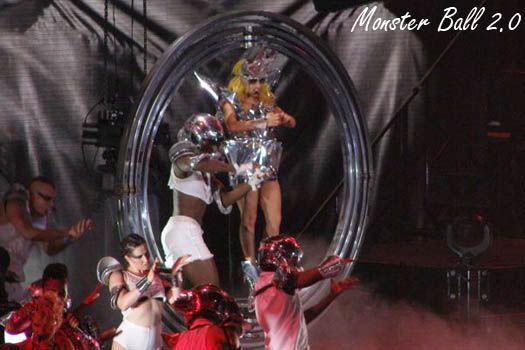
Most, however, are hesitant to crown a new superstar when the star has only been shining for a mere year. Indeed it was only a little over a year prior to this when GaGa first released her first album "The Fame" and first single "Just Dance." After only a year of success, GaGa was no doubt unsure of her ability to sell out arenas. As a result, the first leg of her Monster Ball Tour (called 1.0 by her fans) was booked in theaters throughout the U.S. (in Los Angeles, it was held at the 7100-seat Nokia Theatre).
Herein lied both the greatest flaw as well as, to an extent, the greatest asset of the Monster Ball 1.0: the venue size. Lady GaGa had already demonstrated through various television appearances that her performances are big, outrageous, and theatrical. One could tell that she strove to do more with the 1.0 show but simply was not capable of doing so in such a small space.
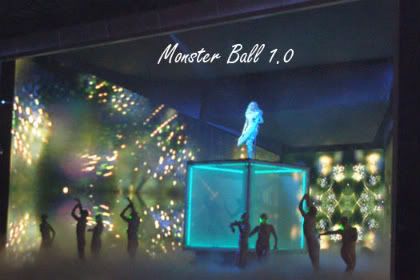
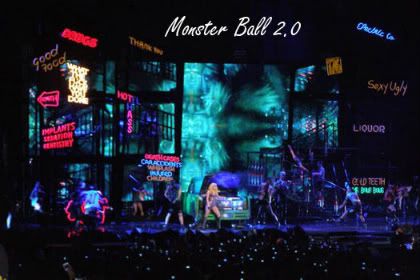
The stage had an interesting shape; it was literally framed into a forced perspective. The background images displayed on the screens were very ornate and interesting, and did a lot to set the mood and tone for any particular song. However, there was not much else to the set aside from GaGa and her dancers.
Perhaps the most blatant example of the constraints GaGa faced in a theater-sized venue was "Paparazzi." In 1.0, GaGa sings the song while perched atop a railing. From each of her braids, a dancer was attached on the stage, and the song ended with GaGa's death. This performance was odd and anti-climactic in itself, but was even more obviously so after seeing how the song was performed in 2.0.
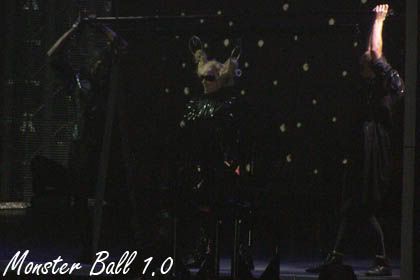

The Monster Ball 2.0, on the other hand, took place at the Staples Center, an arena that seats about 20,000 people. In this version of the song, a giant "Fame Monster" with huge teeth and flopping tentacles appeared on stage. GaGa "fought" the monster throughout the song (even enlisting the audience's help to kill it by taking its picture) and ultimately faced her "death" when she was succumbed by the monster. This second version of the song truly displayed the outrageous and original type of performances GaGa is capable of and has become known for, which she was unable to do in 1.0.
In many cases, however, 2.0 did not deviate from the ideas used in 1.0 as harshly as it did in "Paparazzi." Instead, GaGa took the best parts of 1.0 and incorporated them into 2.0, sometimes even expanding on them. "Bad Romance," which was the encore for both shows, featured the same "Orbit" machine, as well as the same choreography. GaGa and her dancers merely had more complex costumes that were more shiny and ornate.
"Monster" is another excellent example of how GaGa took an idea from 1.0 and expanded and improved it for 2.0. In 1.0, the song had one simple tree on the stage that matched the trees displayed on the background screens. In the 2.0 show, a similar background was used on the screens (meant to simulate a creepy version of Central Park in both shows), however, there was a band on stage, multiple trees (not just one), and lighting effects in addition to GaGa and her dancers.
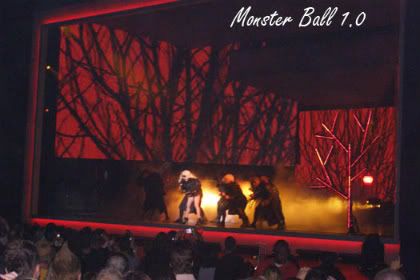
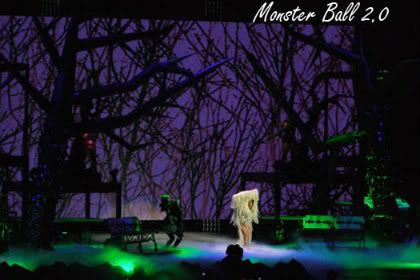
Both 1.0 and 2.0 even had the dancers circle around GaGa and hide her from the audience completely, as if they were eating or attacking her. In 1.0, she merely emerged from the center of the crowd of dancers without the black feathered jacket she was wearing. In 2.0, she literally shot up from beneath the stage, covered in blood, in a different spot on stage from where all the dancers were still standing in a circle.
Her piano segments in both shows also illustrate the improvements made in 2.0. The 1.0 piano was not traditional looking, but the 2.0 piano had a beautiful flame of fire burning from its top. Again, such theatrics were most likely not possible to achieve in a smaller theater setting.


However, this same piano section also demonstrates the greatest setback suffered from the arena setting: the loss of intimacy. When you take out all the theatrics, dancers, and background screens, and all you have left on stage is the artist and her instrument, one is simply better able to connect in a smaller venue. In the 1.0 show, in the middle of "Speechless," GaGa first introduced the monster claw symbol to her fans, explaining that she has declared it the universal sign for her 'little Monsters.' In a smaller theater, each person in the audience is able to feel like she was talking directly to them, and singing directly for them when playing the song.
In 2.0, while the piano segment was definitely a highlight of the show because it really spotlighted her vocal and piano abilities, it simply could not have the same effect in a 20,000 person venue. GaGa even began to cry while performing a new song, "You and I," at the August 11th show, but many in the audience failed to even notice because of the distance between them and GaGa, as well as the incredible number of other distractions present in a huge arena.
As GaGa continues to become an even bigger superstar (she just surpassed Britney Spears as the person with the most followers on Twitter), it is nearly impossible for her to ever return to performing in smaller theaters. In most cases, as the Monster Ball 2.0 indicated, this is not a setback by any means. GaGa needs a bigger space to truly turn all her creative and artistic ideas into reality. Indeed, the Monster Ball 2.0 took all of the best parts of 1.0, and made them better: better costumes, better set, better set list (although "Paper Gangsta" and "Eh, Eh (Nothing Else I Can Say)," which were performed in 1.0, were missed).
The 2.0 show was simply more organic--it even had a (very non-complex) storyline to tie together all the sections in the show. Yet, very occasionally, the intimacy of a theater-sized show was definitely missed. I guess there is no way for GaGa to ever reconcile this problem, but I will definitely always feel lucky to have experienced a Lady GaGa concert on a more intimate level, despite how much better she is in an arena setting.

No comments:
Post a Comment